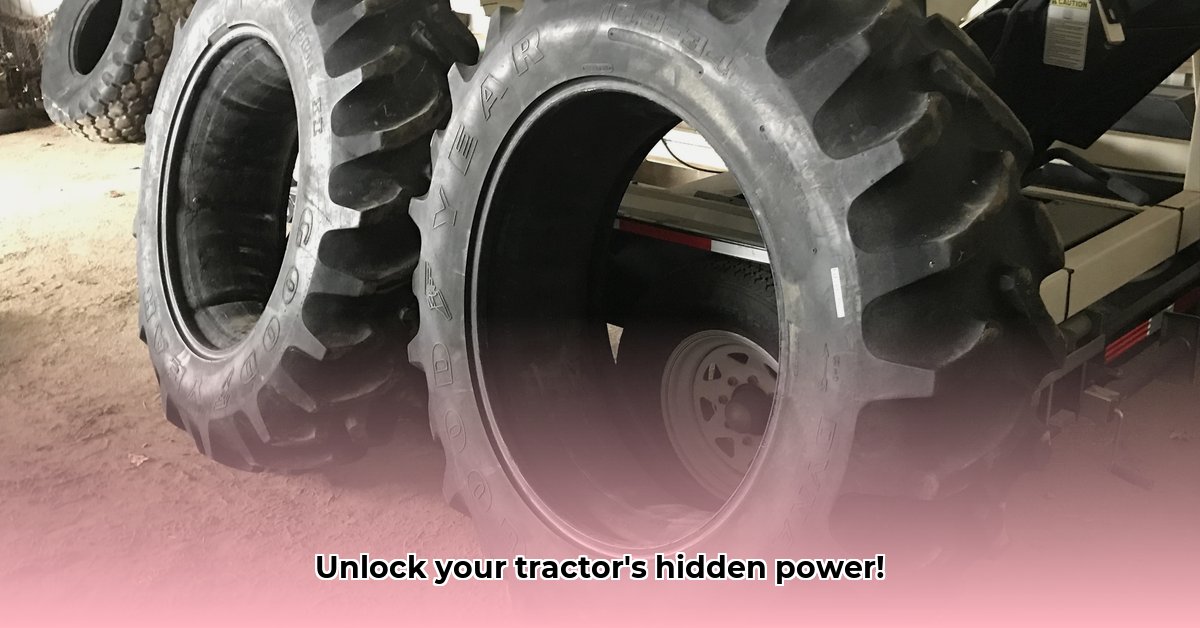
Understanding 16.9-34 Tractor Tire Specifications
The 16.9-34 designation refers to a common tractor tire size: 16.9 inches wide and 34 inches in diameter. These dimensions significantly influence soil compaction, fuel efficiency, and overall environmental impact. Wider tires distribute weight more effectively, reducing ground pressure, while the diameter affects ground clearance. However, tire features beyond size are paramount for sustainability. For more detailed information on 16.9-34 tires, check out this helpful resource.
Tread Patterns: Traction vs. Rolling Resistance
Tread patterns significantly impact both traction and rolling resistance. Deep, aggressive treads provide superior grip in muddy conditions, but increase rolling resistance, leading to higher fuel consumption and increased greenhouse gas emissions. Conversely, shallower treads offer better fuel efficiency on hard-packed soil but may reduce traction in wet conditions. Choosing the appropriate tread pattern for soil type and conditions is crucial for optimal sustainability.
Construction Materials: Environmental Considerations
The materials used in tire construction contribute to their environmental footprint. While traditional rubber compounds are prevalent, increasing emphasis is placed on sustainable alternatives. These include recycled rubber, bio-based materials, and compounds designed to improve tire longevity, reducing the frequency of replacements and reducing waste. Look for manufacturers committed to transparency in material sourcing and production processes.
Pressure Ratings: The Balance Between Compaction and Efficiency
Proper tire inflation pressure is critical for both soil health and fuel efficiency. Underinflation increases ground pressure, leading to soil compaction, reduced water infiltration, and damaged topsoil structure. It also significantly increases rolling resistance, resulting in higher fuel consumption and increased greenhouse gas emissions. Conversely, overinflation concentrates weight, also enhancing compaction, and can lead to premature tire wear. Finding the optimal pressure for various soil conditions is essential for maximizing sustainability. Consult your tractor's manual and local soil conditions for appropriate inflation guidance. Regular pressure checks are imperative.
Soil Health and Tire Management
Soil health is the cornerstone of sustainable agriculture. Tractor tires, particularly larger sizes like 16.9-34, can significantly impact soil compaction if not managed properly. Compacted soil reduces water infiltration, root penetration, and overall soil aeration. This leads to decreased crop yields, increased erosion, and reduced soil carbon sequestration.
Minimizing Compaction: Inflation and Management Strategies
Research shows that even small increases in tire pressure can significantly reduce compaction, while underinflation can dramatically increase it ([Citation needed - Specific study showing impact of pressure on compaction for 16.9-34 tires]). Implementing techniques such as controlled traffic farming (CTF), which involves restricting vehicle movement to designated paths, can also minimize compaction in high-traffic areas. Using wider tires helps distribute weight more evenly, reducing the degree of soil compaction and damage.
Fuel Efficiency and Emissions: Reducing Your Carbon Footprint
Fuel efficiency is directly tied to greenhouse gas emissions. Rolling resistance, the force opposing a tire's motion, is primarily influenced by tire inflation, tread design, and tire condition. The lower the rolling resistance, the less fuel the tractor consumes. This translates to decreased greenhouse gas emissions (CO2, methane, etc.) and lower operational costs.
Optimizing Fuel Consumption: Practical Strategies
- Proper Inflation: Maintaining the correct tire pressure for the given conditions is the single most effective way to reduce rolling resistance and improve fuel efficiency.
- Tire Maintenance: Regularly inspect tires for wear and tear. Promptly addressing damage like cuts or punctures prevents further rolling resistance increases.
- Load Management: Avoid overloading the tractor, which increases rolling resistance and fuel consumption.
- Driving Techniques: Smooth acceleration and deceleration limit unnecessary sliding and fuel waste.
Lifecycle Assessment: From Manufacturing to Disposal
The environmental impact of a tire extends beyond its operational use. Manufacturing processes, including rubber production and tire assembly, consume significant energy and resources, yielding greenhouse gas emissions. The end-of-life disposal of worn-out tires adds further environmental consequences if not responsibly handled. Tires often end up in landfills, where they leach harmful chemicals into the environment.
Sustainable Disposal: Recycling and Responsible Waste Management
Responsible disposal involves recycling or repurposing used tires. Many tire retailers offer tire recycling programs. Inquire about local options for responsibly disposing of your worn tires to prevent environmental contamination from rubber and its additives.
Practical Guidance for Farmers: Actionable Steps
- Regular Tire Pressure Checks: Use a reliable pressure gauge before each use. Adjust pressure based on soil conditions (wet, dry) and load.
- Tire Inspection and Maintenance: Regularly check for cuts, punctures, and uneven wear. Replace worn tires promptly.
- Sustainable Tire Selection: Choose tires from manufacturers committed to sustainable materials and manufacturing practices. Consider the lifecycle impacts.
- Responsible Tire Disposal: Utilize local tire recycling programs or authorized disposal facilities. Avoid improper disposal methods.
Conclusion: Integrating Sustainable Practices
Choosing the right 16.9-34 tractor tires and managing them effectively are instrumental in promoting sustainable agriculture. By prioritizing proper inflation, regular maintenance, responsible disposal, and sustainable tire selection, farmers can significantly reduce their environmental impact while improving operational efficiency and profitability. Continuous research and advancements in tire technology pave the way for continued improvements in sustainability. By staying informed and proactive, farmers can make a meaningful contribution to environmental stewardship while enhancing the profitability and longevity of their operations.